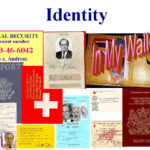This week the following title caught my eye Why Authentication Needs to Simplified for Users and Organizations. As one of those users who wants authentication to be easier, I was driven to reflect back on what companies have offered as mechanisms to secure this amazing landscape called the World Wide Web or the Internet. Each of the four devices on the right are samples of the primary factor “What You Have”. They date back over 25 years and each included a Secure Element currently referred to as a Restricted Operating Environment ROE. The one with the keyboard was issued to me by my european bank in the 90’s. It was used as step up authentication to secure the transfer of funds.
Cumbersome to say the least. I had to enter a PIN, a number displayed on the screen then type the number displayed on LCD into a field on my personal computer. What I always asked myself, why can’t they integrate that thing inside my keyboard or laptop.
Reflecting forward and thinking about what we have to do today to authenticate ourselves. We are confronted with a myriad of solutions each different each claiming to be the right answer to the wider question. Secret questions, PINs, patterns, passwords, an SMS or email with one time passcode, the Google authenticator, the Microsoft authenticator, the FIDO U2F keys, the Fingerprint sensor on my phone, the camera on my desk top, how I use my mouse, where I am located, is there a cookie in my machine.
On top of all of those commercial solutions, there are numerous demo authenticators clients and prospects have asked me to look at.
Each different.
Each requiring the user to appreciate when and how to use it.
What is the answer. First we must agree on the requirements.
- Convenient
- Intuitive
- Easy to Integrate
- Secure
Starting with secure it must be able to offer a unique method of authentication that cannot be spoofed, counterfeit or otherwise compromised. It must have a false accept rate approaching zero and a false reject rate also approaching zero.
As it relates to easy to integrate the people who manage IAM (identity & access management systems – learn this here now), computers, and applications need to be able to quickly and with a minimum of effort, replace what is now used to identify and authenticate the user, with something new.
Intuitive this is the real challenge. There is the variety of users that must be considered. Are they their willing to learn or capable to make the leap, we hope they will?
Finally convenient which demands fast, easy, memorable and even something that is device independent.
How did we get here? Nobility provided individuals letters of introduction, sealed with wax and a signet ring to confirm the origin. This letter assured the attributes, capabilities and identity of the carrier. We trusted because of the seal we recognized
We, one of 7 billion people on this planet, have more contacts on LinkedIn, Facebook and a myriad of other social networks than many towns and cities when a ring and wax was an effective means of authentication.
Today we carry a number of documents. Each designed to provide proof of our identity. We simultaneously expect schools, employers, friends and other agents to be ready to offer proof of our claims. Did we graduate? Did we work there? Are we of good character? Did we received particular certificate?
Insurance companies, airlines, merchants, hotel and banks all provide cards and other means of identity. Each designed to inform someone of our rights, privileges or capabilities.
But, and this is a big but. We do not have an effective and convenient way of sharing these rights, attributes, and privileges on the internet. We let people identify themselves with user Ids and passwords. As the number of digital relations grow the challenge of maintaining secure passwords gets worse. As the challenges of phishing and vishing attacks got more sophisticated the risks, fraud and loses escalated.
We understand these challenges helped to secure card payment systems, were involved in defining new authentication standards and have seen and been exposed to way more ideas than necessary. Happy to help your organization’s secure your consumer and employee relationships.




